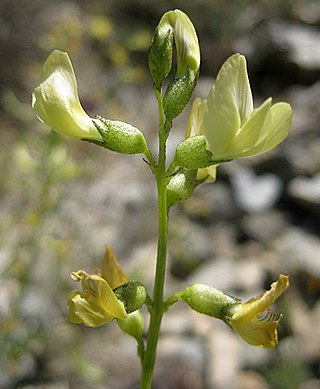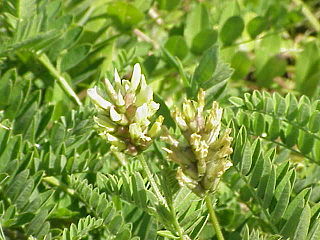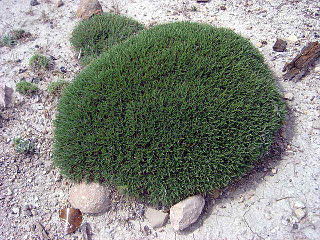Astragalus anxius is a rare species of milkvetch known by the common names troubled milkvetch and Ash Valley milkvetch. It is endemic to northern Lassen County, California, where it is critically imperiled. It was formally described in 1992.

Astragalus asymmetricus is a species of milkvetch known by the common name San Joaquin milkvetch. It is endemic to California, where it grows in grassy and disturbed areas in the Central Valley and nearby parts of the Central Coast Ranges and San Francisco Bay Area.

Astragalus brauntonii is a rare species of milkvetch known by the common name Braunton's milkvetch. It is endemic to California, where it is known from fewer than 20 extant occurrences in the hills and mountains surrounding the Los Angeles Basin in Southern California. This is a federally listed endangered species in the United States.

Astragalus casei is a species of milkvetch known by the common name Case's milkvetch. It is native to the Mojave Desert and its sky island woodlands of eastern California and western Nevada.
Astragalus cimae is a species of milkvetch known by the common name Cima milkvetch. It is native to the Mojave Desert and its sky island woodlands of eastern California western Nevada, especially on calcareous soils, including the Cima Dome area in the Mojave National Preserve.
Astragalus claranus is a rare species of milkvetch known by the common names Clara Hunt's milkvetch and Napa milkvetch. It is endemic to northern California where it is known from only four or five occurrences along the border between Sonoma and Napa Counties. It is a federally listed endangered species.

Astragalus clevelandii is an uncommon species of milkvetch known by the common name Cleveland's milkvetch. It is endemic to northern California, where it grows in moist areas of the North Coast Ranges. It is a member of the serpentine soils flora.

Astragalus didymocarpus is a species of milkvetch known by the common names Dwarf white milkvetch and Two-seeded milkvetch. It is native to the southwestern United States and northern Mexico, where it can be found in many types of habitat.

Astragalus filipes is a species of milkvetch known by the common name basalt milkvetch. It is native to western North America from British Columbia to California to Utah, where it grows in many types of habitat, especially dry areas.
Astragalus panamintensis is a species of milkvetch known by the common name Panamint milkvetch.

Astragalus platytropis is a species of milkvetch known by the common name broadkeel milkvetch. It is native to the western United States from Montana to California, where it lives at high elevation in alpine and subalpine plant communities. This is a small perennial milkvetch which forms a small patch of short silvery-green stems on rocky ground. The leaves may be up to 9 cm (3.5 in) long and are made up of several hairy leaflets. The inflorescence is a head of four to nine pale purple flowers, each just under 1 cm (0.39 in) long. The fruit is a bladdery legume pod which can exceed 3 cm (1.2 in) long.

Astragalus pulsiferae is a species of milkvetch known by the common name Ames's milkvetch. It is native to California and Nevada, and it is known but rare in Washington. It is known from many habitat types, including mountains and plateaus.

Astragalus purshii is a species of milkvetch known by the common names woollypod milkvetch and Pursh's milkvetch.

Astragalus rattanii is a species of milkvetch known by the common name Rattan's milkvetch. It is endemic to northern California, where it grows in the North Coast Ranges.

Astragalus tricarinatus is a rare species of milkvetch known by the common name triplerib milkvetch, or triple-ribbed milkvetch.

Astragalus applegatei is a rare species of milkvetch known by the common name Applegate's milkvetch. Its scientific name is also spelt Astragalus applegatii. It is endemic to Klamath County, Oregon, where it is known from three populations, one of which is made up of only three plants. Much of the remaining habitat is seriously threatened by development, introduced plant species, and other forces. This is a federally listed endangered species of the United States.

Astragalus cicer, the chickpea milkvetch, chick-pea milk-vetch or cicer milkvetch, is a perennial flowering plant native to Eastern Europe, popularized and subsequently transported to areas in Southern Europe, North America, and South America. It produces pods that resemble those of chickpeas. Its flowers are usually of pale yellow tint, and attract bumble or European honey bees for pollination. Growth often exceeds 0.6 meters, up to a height of 1 meter in length.
Astragalus hypoxylus is a rare species of flowering plant in the legume family known by the common name Huachuca milkvetch, or Huachuca Mountain milkvetch. It is endemic to Arizona in the United States, where it is known only from the Patagonia and Huachuca Mountains. There are three populations.

Astragalus microcymbus is a species of flowering plant in the legume family known by the common name Skiff Milkvetch. It is endemic to Colorado in the United States, where it is known from Gunnison County and the edge of Saguache County. It was discovered in 1945 by Rupert Barneby, a British botanist. Currently, Skiff Milkvetch is experiencing population declines and is listed as Threatened.

Astragalus balearicus, commonly known as the Balearic milkvetch or gatovell, is a small legume of the genus Astragalus that is found on the Balearic Islands off the coast of Spain.














